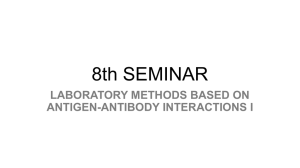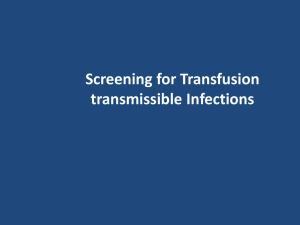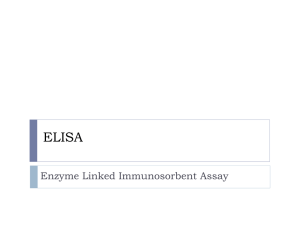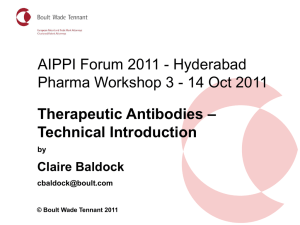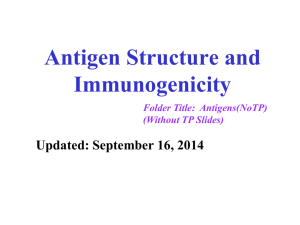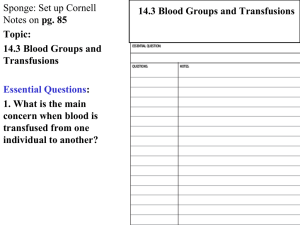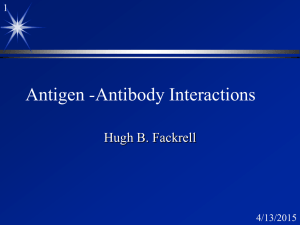Serology of Fungal infections
advertisement
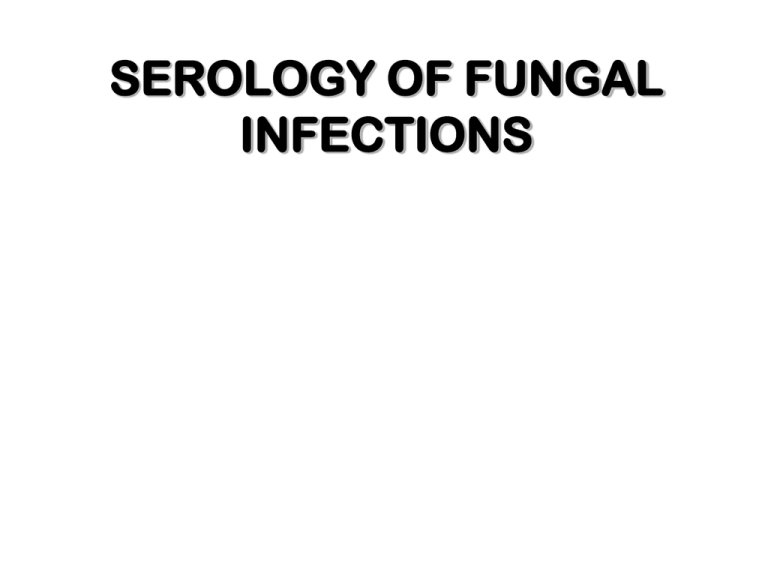
SEROLOGY OF FUNGAL INFECTIONS Diagnosis in the setting of increasing fungal burden Biological infection Clinical infection Pathological changes INFECTION Fungitell Aspergillus PCR Aspergillus GM Current diagnostic methods Targeted prophylaxis/ Pre-emptive therapy Empirical/targeted therapy SEROLOGICAL TARGETS Serology methods utilise the reactions and properties of serum • ANTIBODIES (Use of commercially available antigens) Exo-antigen Antigen • ANTIGENS (Use of specific antibodies) Antibody Why use serology • Antigens and antibodies are easier to detect than finding the organism directly • Antigens and antibodies are produced in large quantities and can be found in body fluids (blood, CSF, urine, BAL) • Culture is often problematic, time consuming and insensitive due to the low concentration of the organism in tissue Available tests Antibodies • Immunodiffusion • Radioallergosorbent Test (RAST) Antigens • Latex Agglutination • Radioimmunoassay (RIA) Antibodies and antigens • Complement fixation • Enzyme-linked immunosorbent assay (ELISA) • Enzyme Immunoassay (EIA) Measures of Accuracy in Serology Assays • Sensitivity – Quantifies the number of false negatives – 80% sensitivity = 80/100 patients with culture positive sample produce positive result in test • Specificity – Quantifies the number of false positives – 80% specificity = 20/100 healthy volunteers with no disease produce positive test result • Results are variable depending on factors such as patient group and monitoring Mycotic diseases • Aspergillosis • Candidiasis Opportunistic pathogens Antigen & antibody (?) detection True pathogens Antigen & antibody (?) detection • Cryptococcosis • Histoplasmosis • Blastomycosis • Coccidioidomycosis • Paracoccidioidomycosis Aspergillosis Primary aetiological agents: A. fumigatus, A. flavus, A. niger, A. terreus. Aspergillus spp. have a global distribution: - airborne spores, - soil, - water supplies, - construction sites, - pillows. Treatment strategies based on the pathophysiology of aspergillosis McCormick et al. 2010 Aspergillosis Serological Diagnosis • Diagnosis of invasive disease – Based on the detection of Aspergillus antigens – ELISA kits to detect Galactomannan and -Glucan • Diagnosis of allergic disease – Based on the detection of IgE by RAST/ELISA. – May also use complement fixation or Immunodiffusion. DIAGNOSTIC TOOLS 1976 DIAGNOSTIC TOOLS 1979 DIAGNOSTIC TOOLS 2011 Sandwich-ELISA •galactomannan •mannan High-resolution CT-scan Ultrasound Bronchoalveolar lavages Biopsy techniques (BLOOD)CULTURES Fungitell (-1-3-D-glucan) PCR Aspergillosis Diagnosis of invasive disease Galactomannan (GM) - polysaccharide component of the cell wall - highly immunogenic antigen - present in most Aspergilli - exo-antigen that can be detected in serum, BAL or CSF - monitoring of GM during antifungal therapy allows progression of treatment to be measured - several commercially available ELISA tests (Platelia, Pastorex) However... - GM presence in patient’s blood is determined by multiple factors - sensitivity of GM detection depends on the site of infection - certain antibiotics (e.g. ampicillin, amoxicillin, amoxicillin-clavulanate) may give false-positive results - Aspergillosis should also be confirmed by other diagnostic tools (CT) Kedzierska et al, Eur J Clin Microbiol Infect Dis (2007) 26:755 Aspergillosis Antigen Tests: Galactomannan Patient group Sensitivity (%) Specificity (%) Allo HSCT, neutropenia, all on steroids 96 99 Neutropenia, suspected IA, GVHD, steroids 100 93 Allo HSCT 81 89 Haematologic malignancy 80 82 Neutropenia, Cut Off 1.5 88 90 ELISA, LA; Cut off 0.5, except neutopenic group Wheat L.J, Transplant Infect Dis (2006), 8:128 Aspergillosis (1→3)-β-D-glucan - widely distributed in nature (fungi, yeast, algae, bacteria, plants) - not present (or low) in Cryptococcus species, zygomycetes and humans - exo-antigen - may also be used in diagnosis of candidiasis or fusariosis - commercially available kits: Fungitec-G, Fungitell - may be used as a complementary test to GM However... - false-positive results may occur (60% of bacteraemic patients) Kedzierska et al, Eur J Clin Microbiol Infect Dis (2007) 26:755 Aspergillosis Antigen Tests: (1→3)-β-D-glucan Patient group Sensitivity (%) Specificity (%) Haematologic disease 88 85 Neutropenia, suspected IA, GVHD, steroids 55 95 Neutropenia, Cut off 120 pg/ml 88 90 Cut off 60 pg/ml, except neutorpenic group Wheat L.J, Transplant Infect Dis (2006), 8:128 Aspergillosis Diagnosis of allergic Aspergillosis Antibody Test Aspergillus antibodies can only be detected in ABPA, Aspergilloma and CCPA patients. Less reliable than antigen tests due to the presence of anti-Aspergillus antibodies in healthy individuals. High level of precipitating antibodies does not prove the presence of ongoing disease Aspergillus precipitin test Strong reactions: indicative of aspergilloma ImmunoCAP • IgE • IgG • ABPA: – asthma – cystic fibrosis – COPD – cavitary disease Candidiasis Primary aetiological agents: C. albicans, C. parapsilosis, C. glabrata, C. tropicalis. Diagnosis: Based on detection of: -antigen: > β-glucan (Fungitec-G – enzymatic assay) > Mannan (Pastorex, Platelia - ELISA) - antibody (?) (IgA, IgG – ELISA, Immunodiffusion) Candidiasis Antigen Test Mannan - highly immunogenic antigen - immunologically more active then β-glucan - polysaccharide component of the cell wall of Candida spp. - positive results may be obtained 2-15 days before positive blood cultures - commercially available tests: Pastorex and Platelia (ELISA) However... - negative results of the tests do not exclude infection Kedzierska et al, Eur J Clin Microbiol Infect Dis (2007) 26:755 Candidiasis Antigen Test Test LA mannan (Pastorex) MAb Sensitivity (%) Specificity (%) 25-28 100 ELISA mannan (Platelia) MAb 42 93-98 ELISA mannan (Platelia) PAb 21-84 98-100 β-glucan (enzymatic – Fungitec-G) 71-97 54-96 MAb – monoclonal antibody PAb – polyclonal antibody Yeo & Wong, Clin Micro Rev (2002) 15:465 Candidiasis Antibody Test Sensitivity ~80% in immunocompetent individuals Anti-Candida antibodies may also be present in healthy individuals and cause false possitive results Sensitivity may not be relevant in immunocompromised individuals IMMY laboratory manuals Cryptococcosis Primary aetiological agent: C. neoformans Diagnosis: Only based on detection of capsular polysaccharide (glucuronoxylomannan) antigen No antibody tests performed Several tests: Latex agglutination (PREMIER Cryptococcal antigen assay) Enzyme Immunoassay (Pastorex Crypto Plus, IMMY LatexCryptococcus antigen assay) Cryptococcosis Antigen Test - detection in serum, BAL or CSF - false-positive results may be caused by rheumatoid factor or crossreactive organisms (Trichosporon asahii) Test Sensitivity (%) Specificity (%) Latex Agglutination 90 95 ELISA MAb 90 70-80 Yeo & Wong, Clin Micro Rev (2002) 15:465 Santangelo, Med Mycol (2005) 43:335 The future? Conclusion • Serology is a useful tool for rapid diagnosis of fungal disease • Results may be obtained within a few hours without the need of culture • Results may also be obtained several days before clinical symptoms develop • More work needs to be done on candidosis serological testing • Continued screening allows clinicians to follow the progress of the disease – however may be difficult to obtain appropriate specimens • Kits are expensive making continuous monitoring difficult



